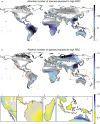More than 17,000 tree species are at risk from rapid global change
- PMID: 38167693
- PMCID: PMC10761716
- DOI: 10.1038/s41467-023-44321-9
More than 17,000 tree species are at risk from rapid global change
Abstract
Trees are pivotal to global biodiversity and nature's contributions to people, yet accelerating global changes threaten global tree diversity, making accurate species extinction risk assessments necessary. To identify species that require expert-based re-evaluation, we assess exposure to change in six anthropogenic threats over the last two decades for 32,090 tree species. We estimated that over half (54.2%) of the assessed species have been exposed to increasing threats. Only 8.7% of these species are considered threatened by the IUCN Red List, whereas they include more than half of the Data Deficient species (57.8%). These findings suggest a substantial underestimation of threats and associated extinction risk for tree species in current assessments. We also map hotspots of tree species exposed to rapidly changing threats around the world. Our data-driven approach can strengthen the efforts going into expert-based IUCN Red List assessments by facilitating prioritization among species for re-evaluation, allowing for more efficient conservation efforts.
© 2024. The Author(s).
Conflict of interest statement
The authors declare no competing interests.
Figures




References
-
- Newton, A. C. Ecosystem Collapse and Recovery. (Cambridge University Press. 10.1017/9781108561105 (2021).
-
- García-Robledo C, et al. The Erwin equation of biodiversity: From little steps to quantum leaps in the discovery of tropical insect diversity. Biotropica. 2020;52:590–597. doi: 10.1111/btp.12811. - DOI
-
- BGCI. State of the World’s Trees. https://www.bgci.org/wp/wp-content/uploads/2021/08/FINAL-GTAReportMedRes... (2021).
Publication types
MeSH terms
Grants and funding
LinkOut - more resources
Full Text Sources
Research Materials

